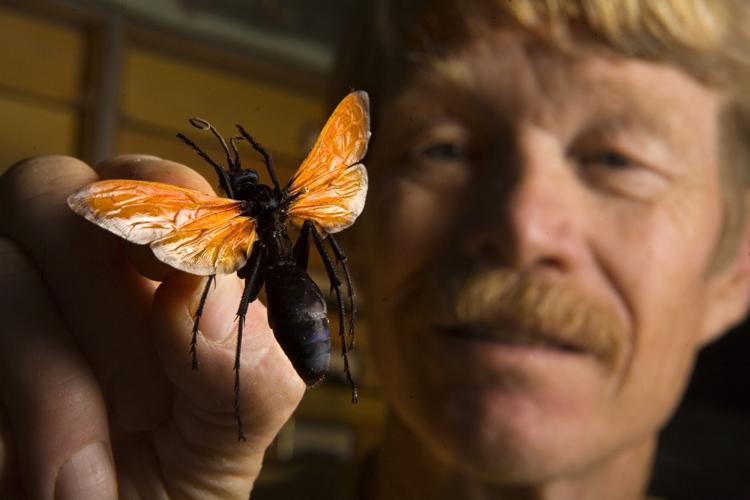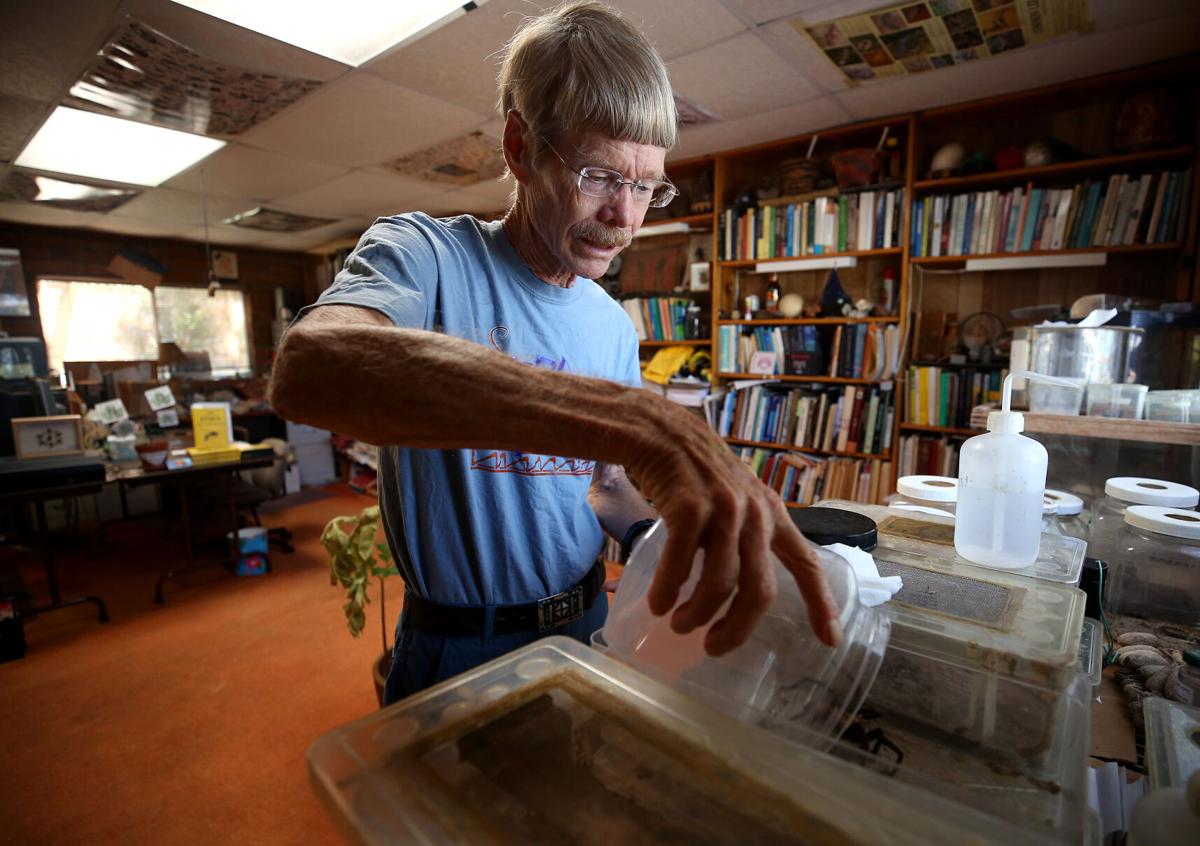He made scientific discoveries about bee nutrition and insect defenses, but pain is where Justin O. Schmidt really made a name for himself.
The long-time Tucson entomologist created his own ranking system — complete with a numerical scale and colorful descriptions — to describe the experience of being stung by more than 100 different kinds of ants, bees and wasps from around the world.
The inventor of the Schmidt sting pain index died on Feb. 18 from Parkinson’s disease at his home in Tucson with his family at his side. He was 75.
“He was one of the most insatiably curious people I’ve ever met,” said pollination ecologist and University of Arizona adjunct professor Stephen Buchmann, a close friend and colleague of Schmidt for more than 40 years. “He was always thinking and asking deep questions.”
Often that led to him getting poked by something. By Schmidt’s own estimates, he was bitten or stung at least 1,500 times by about 150 different species of insects over the course of 50 years.
“I lost count a long time ago,” he told the Arizona Daily Star in 2020.
He said a lot of his stings were the result of “simple sloppiness” while handling insects for his research. Other stings were intentional, like the time he saw a great big cicada-killer wasp on a flower outside his lab and scooped it up with his bare hand.
“When the opportunity comes, you grab it sometimes, literally,” he said.
Pain brings fame
Schmidt grew up in Central Pennsylvania, where competing interests in insects and chemistry set him on a path to one day become the so-called “King of Sting.”
After earning his bachelor’s degree from Penn State, he moved to British Columbia for his master’s, Georgia for his Ph.D and New Brunswick for his post-doctoral work, before settling for good in Tucson.
He spent his first 25 years here on staff at the U.S. Department of Agriculture’s Carl Hayden Bee Research Center, where he investigated the physiology, ecology, diet and behavior of honey bees.
Then the father of four struck out on his own to continue and expand his research through the UA, where he was an adjunct scientist, and the Southwestern Biological Institute, a nonprofit venture he launched in the mid-1980s.

In this 2007 photo, U of A entomologist Justin O. Schmidt holds the notorious tarantula hawk, the only local creature rating a 4 on his pain index. But don’t worry — this one’s dead.
Schmidt first began exploring the different kinds of pain associated with stinging insects in the early 1970s and published his first version of the pain index in the early 1980s. Over the ensuing decades, he expanded and refined the index as he encountered the pointy ends of more and more bugs.
His definitive work on the subject is “The Sting of the Wild,” an acclaimed 2016 book about ants, bees and wasps and his painful pursuit to understand them.
The Schmidt sting pain index ranges from 0 (no effect at all) to 4 (absolute misery), with the common honey bee smack in the middle at 2.
Only three insects qualify for a 4: the bullet ant and the warrior wasp from Central and South America and Arizona’s own tarantula hawk, that familiar, blue-black wasp with the bright orange wings.
“Stung by a tarantula hawk? The advice I give in speaking engagements is to lie down and scream,” Schmidt wrote in “The Sting of the Wild.”
The pain only lasts a few minutes, but it is blinding and electric “like someone dropping a hair dryer in your bubble bath,” he told the Star in 2020.
Other stings produce their own distinct sorts of pain, and Schmidt clearly delighted in the differences: The warrior wasp was like being “chained in the flow of an active volcano”; the bullet ant like “walking over flaming charcoal with a 3-inch nail embedded in your heel”; the artistic wasp like a loving marriage dissolving into divorce, “pure, then messy, then corrosive.”
Such visceral descriptions drew attention outside the usual scientific circles.
Schmidt was interviewed more than 200 times by major television, radio and news publications around the world. He was almost certainly the only entomologist on Earth to appear on “Jimmy Kimmel Live!” and have his name dropped in a Marvel superhero movie (“Ant-Man,” naturally).
In 2015, he shared the Ig Nobel Prize for physiology and entomology, a satirical honor handed out for “achievements that make people laugh, and then make them think.” Schmidt showed up to the award ceremony at Harvard University dressed like a bee and read a poem about getting stung.
A friend to bugs
“He was a great spokesman for insect science and biology as a whole,” said entomologist Gene Hall, who manages the insect collection at the UA.
Hall was still a student when he first met Schmidt close to 40 years ago, and he counts himself lucky to have gotten to join him on a few research trips into the desert.
“He was the consummate field biologist. Being out in the field with him was a great educational experience for me,” Hall said. “I always learned something from Justin.”
Schmidt’s research credits include more than 200 scientific and peer-reviewed articles, three edited volumes and several hundred scientific presentations.
He was also an outspoken advocate for insects, eschewing pesticides and bristling at phrases like “killer bee” or “murder hornet” that invite fear instead of understanding.
“The reason we make up these terms is because we’re afraid of them,” Schmidt once explained.

Justin O. Schmidt, an entomologist at the University of Arizona, looks at wingless wasps through a microscope in 2017.
Buchmann said his friend was an expert on a number of different insects. It was Schmidt who figured out that harvester ants like the ones so prevalent in Southern Arizona produce one of the most lethal venoms in the insect world, albeit in extremely tiny doses.
“It’s the equivalent of cobra venom, which explains why it hurts so much” when the ants sting you, Buchmann said.
One of Schmidt’s final papers — co-authored with his wife, Li, and published in August — compiles more than 30 years of his research on the giant velvet mite, a bright red arachnid that only emerges for a few days a year during the summer monsoons in the Sonoran Desert.
Schmidt struggled for years to figure out what predators, if any, preyed on the fat, slow-moving critters. Nothing seemed to want to eat the mites, so he decided to sample one for himself.
He described the flavor in a recent interview with University of Arizona News, calling it bitter, sharp and deeply unpleasant, “like mixing quinine with habanero.”
Buchmann had to laugh when he heard about that. To him, it perfectly illustrates the kind of scientist and the kind of man Schmidt was: A master’s degree in chemistry, decades of research on insect defenses, and he still couldn’t help himself in the face of overwhelming curiosity.
“It didn’t surprise me at all that he would pop one in his mouth to see what it tasted like,” Buchmann said.
Entomologists are preparing for 2024, when two groups of cicadas will emerge at the same time -- a rare synchronized occurrence in the insect world.







